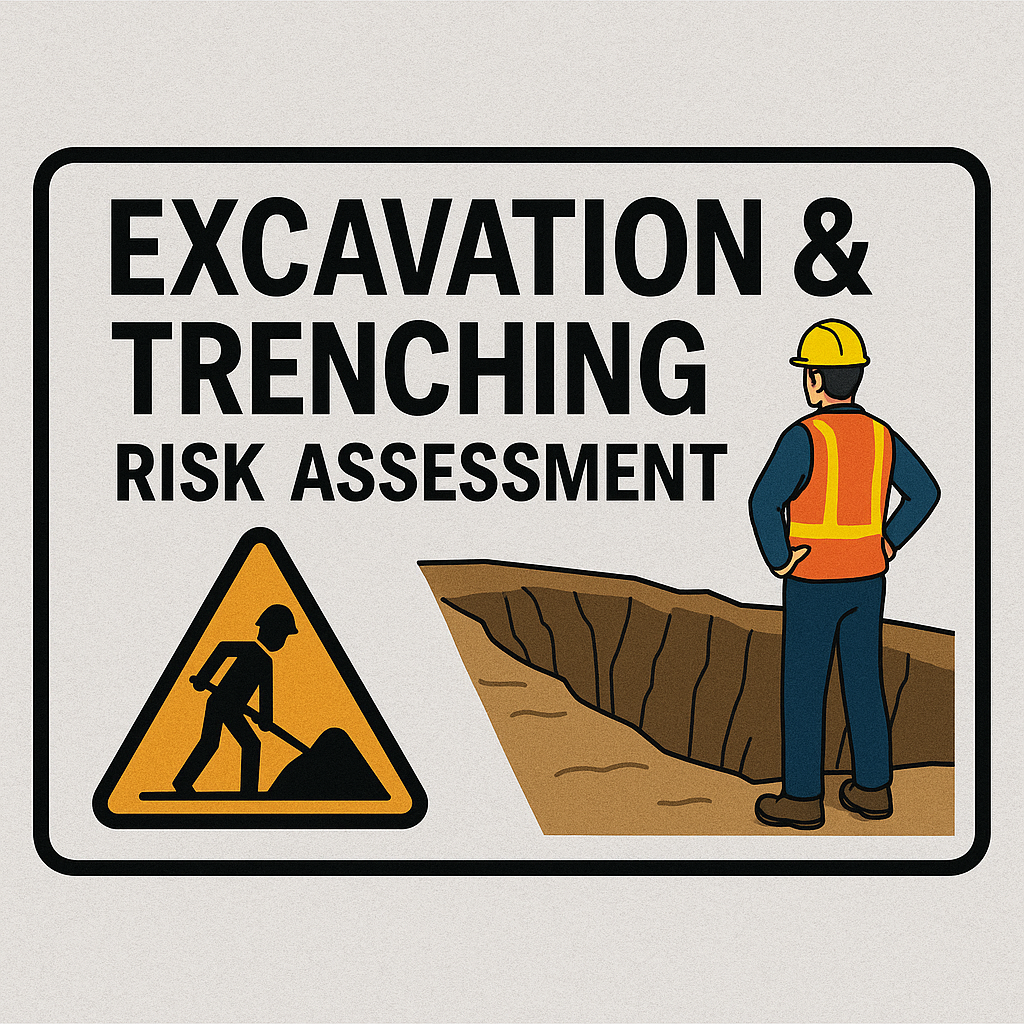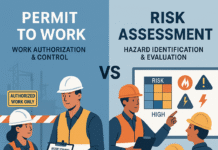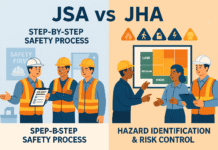
Excavation & Trenching Risk Assessment
Excavation and trenching are among the most dangerous operations in construction. A single collapse can bury a worker under tons of soil in seconds. That’s why Excavation & Trenching Risk Assessment is not just a safety formality—it’s a life-saving step.
This article will guide you through how to properly assess risks, implement controls, and ensure safe excavation practices at any job site.
📜 Legal Standards and Safety Guidelines
OSHA Regulations (USA)
- 29 CFR 1926 Subpart P – Excavations
- Requires protective systems for any trench over 5 feet deep unless made in stable rock.
HSE Guidelines (UK)
- Mandate a safe system of work and competent person inspections.
Indian Standards
- IS 3764:1992 – Excavation Work Safety Code
- BOCW Act and Rules – Apply to construction workers and excavations
ISO 45001:2018
- Risk-based thinking applied to excavation and confined space tasks
⚠️ Common Hazards in Excavation and Trenching
| Hazard | Description |
|---|---|
| Cave-in | Most fatal hazard; soil walls collapse onto workers |
| Falls | Workers or equipment falling into unprotected excavation |
| Hazardous Atmosphere | Lack of oxygen or presence of toxic gases |
| Utility Strike | Hitting underground cables, gas lines, or water pipes |
| Falling Objects | Materials or tools falling into trench |
| Water Ingress | Flooding due to poor drainage or weather conditions |
| Mobile Equipment | Vehicles or excavators tipping into the excavation |
🏗️ Types of Excavation Activities
- Manual Excavation – Using shovels, picks; generally <1.2m depth
- Mechanical Excavation – Backhoes, JCBs, trenchers
- Deep Trenching – More than 1.5 meters; high-risk operations
📋 Excavation Risk Assessment: Step-by-Step
1. Task Breakdown
Identify what is being done: site marking, digging, pipe laying, backfilling, etc.
2. Hazard Identification
Assess hazards for each step:
- Who is exposed?
- What could go wrong?
- What would the consequences be?
3. Evaluate Risk
Use the 5×5 Matrix (see next section) to prioritize and classify risks.
4. Implement Controls
Choose the best available control based on the hierarchy of controls:
- Eliminate
- Substitute
- Engineer
- Administrative
- PPE
5. Monitor and Review
Review assessments:
- Daily by a competent person
- After rainfall or any collapse
- When excavation depth/width changes
📊 5×5 Excavation Risk Matrix
| Severity ↓ / Likelihood → | Rare (1) | Unlikely (2) | Possible (3) | Likely (4) | Almost Certain (5) |
|---|---|---|---|---|---|
| Insignificant (1) | 1 | 2 | 3 | 4 | 5 |
| Minor (2) | 2 | 4 | 6 | 8 | 10 |
| Moderate (3) | 3 | 6 | 9 | 12 | 15 |
| Major (4) | 4 | 8 | 12 | 16 | 20 |
| Catastrophic (5) | 5 | 10 | 15 | 20 | 25 |
- 1–3 (Green): Low Risk
- 4–6 (Amber): Medium Risk
- 7–15 (Red): High Risk
- 16–25 (Dark Red): Extreme Risk – Work must not proceed
📌 Sample Excavation & Trenching Risk Assessment Table
| S.No | Task | Hazard | Risk (L×S) | Risk Level | Control Measures | Responsible |
|---|---|---|---|---|---|---|
| 1 | Digging trench (1.5m deep) | Cave-in | 4×5 = 20 | Extreme | Use shoring or trench box, inspect soil, no entry without protective system | Site Engineer |
| 2 | Laying pipes in trench | Hazardous gas exposure | 3×4 = 12 | High | Gas detector, ventilation blower, trained personnel only | Supervisor |
| 3 | Excavation near utilities | Cable/gas pipe strike | 3×5 = 15 | High | Use cable locators, hand dig in utility zones, notify utility provider | Excavator Operator |
| 4 | Rainy season trench work | Water accumulation/slip hazard | 4×4 = 16 | High | Sump pump, proper drainage, delay work during heavy rain | HSE Officer |
| 5 | Entering trench for welding | Oxygen deficiency | 2×5 = 10 | High | Confined space procedure, oxygen level check, entry permit | Welder Supervisor |
| 6 | Mobile crane near trench | Ground collapse | 3×4 = 12 | High | Maintain safe distance (1:1 depth rule), use crane mats, assess soil stability | Crane Operator |
🧱 Soil Classification and Stability
Soil Types:
- Type A – Stable rock/clay; least risk
- Type B – Sandy loam, silty clay; moderate risk
- Type C – Sand, gravel, loamy soil; highest collapse risk
Use a penetrometer or visual/manual test to classify.
Importance:
The more unstable the soil, the more protection needed (shoring, shielding, benching).
🛡 Excavation Protection Systems
| Method | Description | When to Use |
|---|---|---|
| Sloping | Angling trench walls to prevent collapse | For stable soil types (A/B) |
| Benching | Stepped cuts into trench wall | Depth > 1.2m with Type B soil |
| Shoring | Using supports like timber, aluminum, or hydraulic shores | Type C soil or >1.5m deep |
| Shielding | Trench boxes or trench shields | Repetitive deep excavation |
🔎 Utility Detection and Marking
Before any digging:
- Use Ground Penetrating Radar (GPR)
- Participate in Dial Before You Dig programs
- Mark known utilities with color codes (e.g., red for electric, yellow for gas)
🚪 Entry and Egress Requirements
- Trenches >1.2 meters must have access within 25 feet (7.5m)
- Use ladders, ramps, or stairways
- Do not jump in or out of trenches
🌧 Environmental Factors
Excavation safety is highly influenced by:
- Rainfall or groundwater
- Windy conditions near loose soil
- Vibration from nearby machinery
Delay work during inclement weather or use protective tarps and drainage.
🧠 Role of Competent Person
Required by OSHA and most safety laws. Duties include:
- Daily inspections
- Re-inspect after events (rain, collapse, vibration)
- Correct unsafe conditions immediately
- Must have specific excavation training
🚨 Emergency Preparedness
Scenarios to Prepare For:
- Cave-in
- Entrapment
- Gas inhalation
- Electrocution from buried cable
Rescue Plan Includes:
- Rescue tripod and winch
- Confined space breathing apparatus
- Emergency contact display
- Mock drills every quarter
✅ Conclusion
Excavation and trenching can be deadly, but with proper risk assessment, planning, and controls, they don’t have to be.
From soil classification to protective systems, competent supervision to rescue readiness, every detail counts.
If you dig deep, don’t dig your own grave—dig safely.
Lifting & Rigging Operations Risk Assessment
Electrical Work Risk Assessment
Confined Space Entry Risk Assessment
Working at Height Risk Assessment
❓FAQs
1. What depth requires a trench box or protection?
Anything deeper than 5 feet (1.5 meters) requires a protective system unless dug in stable rock.
2. Do all trenches require a permit?
No, but confined or deep trenches (>1.5m, near utilities, etc.) should have an excavation permit and lift plan if equipment is involved.
3. Who is considered a competent person in excavation?
Someone trained in soil analysis, protective systems, hazard recognition, and authorized to correct unsafe conditions.
4. Can workers stay in the trench while it’s being backfilled?
No. Workers must exit before backfilling begins.
5. How often should excavation risk assessments be updated?
- Before work begins
- After design or depth changes
- After weather events
- After any incident
























